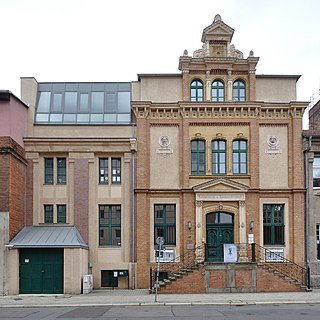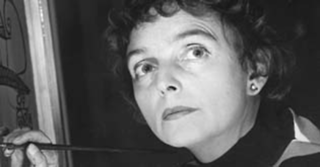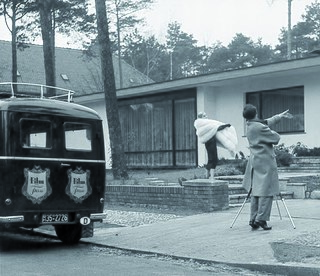Related Research Articles

Klaus Otto Wilhelm Voormann is a German artist, musician, and record producer.

Aribert Reimann is a German composer, pianist and accompanist, known especially for his literary operas. His version of Shakespeare's King Lear, the opera Lear, was written at the suggestion of Dietrich Fischer-Dieskau, who sang the title role. His opera Medea after Grillparzer's play premiered in 2010 at the Vienna State Opera. He was a professor of contemporary Lied in Hamburg and Berlin. In 2011, he was awarded the Ernst von Siemens Music Prize for his life's work.

Lilly Reich was a German designer of textiles, furniture, interiors, and exhibition spaces. She was a close collaborator with Ludwig Mies van der Rohe for more than ten years during the Weimar period in the 1920s and early 1930s. Reich was an important figure in the early Modern Movement in architecture and design. Her fame was posthumous, as the significance of her contribution to the work of Mies van der Rohe and others with whom she collaborated only became clear through the research of later historians of the field.

Gunta Stölzl was a German textile artist who played a fundamental role in the development of the Bauhaus school's weaving workshop, where she created enormous change as it transitioned from individual pictorial works to modern industrial designs. She was one of a small number of female teachers on the Bauhaus' staff and the first to hold the title of "Master".

Désirée Lucienne Lisbeth Dulcie Day OBE RDI FCSD was one of the most influential British textile designers of the 1950s and 1960s. Day drew on inspiration from other arts to develop a new style of abstract pattern-making in post-war British textiles, known as ‘Contemporary’ design. She was also active in other fields, such as wallpapers, ceramics and carpets.

A Kunstgewerbeschule was a type of vocational arts school that existed in German-speaking countries from the mid-19th century. The term Werkkunstschule was also used for these schools. From the 1920s and after World War II, most of them either merged into universities or closed, although some continued until the 1970s.

African wax prints, Dutch wax prints or Ankara, are omnipresent and common materials for clothing in West Africa and Central Africa. They were introduced to West and Central Africans by Dutch merchants during the 19th century, who took inspiration from native Indonesian technique and Akwete cloth designs. They began to adapt their designs and colours to suit the tastes of the African market. They are industrially produced colourful cotton cloths with batik-inspired printing. One feature of these materials is the lack of difference in the colour intensity of the front and back sides. The wax fabric can be sorted into categories of quality due to the processes of manufacturing.

Germany plays an important role in the fashion industry, along with France, the United Kingdom, the United States, Italy, Spain, and Japan. German fashion is known for unconventional young designers and manufacturers of sports and outdoor clothing, ready-to-wear and custom-made creations.
Kurt Erdmann was a German art historian who specialized in Sasanian and Islamic Art. He is best known for his scientific work on the history of the Oriental rug, which he established as a subspecialty within his discipline. From 1958 to 1964, Erdmann served as the director of the Pergamon Museum, Berlin. He was one of the protagonists of the "Berlin School" of Islamic art history.

Otti Berger was born on 4 October 1898 in present-day Zmajevac, Croatia. She was a student and later teacher at the Bauhaus, where she was a textile artist and weaver. She was murdered in 1944 at Auschwitz during the Holocaust.
The handle of stuff is of primary importance. A piece of stuff must be touched and felt; it has to be held in the hands. The beauty of a stuff is above all, known by its feel. The feel of stuff in the hands can be just as beautiful an experience as colour can be to the eye or sound to the ear.
Margaretha Reichardt, also known as Grete Reichardt, was a textile artist, weaver, and graphic designer from Erfurt, Germany. She was one of the most important designers to emerge from the Bauhaus design school's weaving workshop in Dessau, Germany. She spent most of her adult life running her own independent weaving workshop in Erfurt, which was under Nazi rule and then later part of communist East Germany.

Aiga Rasch was a German illustrator, graphic artist and painter.

Bele Bachem was a German graphic artist, book illustrator, stage designer and writer. In 1997, Bachem was awarded the Order of Merit of the Federal Republic of Germany.
Claudia Barainsky is a German operatic soprano. She has performed internationally, and won awards for her roles in contemporary operas such as Bernd Alois Zimmermann's Die Soldaten and Aribert Reimann's Medea.
Joan Carroll is an American operatic coloratura soprano who appeared in the title role of Alban Berg's Lulu at the work's US premiere at the Santa Fe Opera in 1963, and often in opera houses in Europe. She premiered vocal music by Aribert Reimann and Wilhelm Killmayer, among others.

Franz Christian Gundlach was a German photographer, gallery owner, collector, curator and founder.

Wiebke Siem is a German mixed media artist of German and Polish heritage, winner of the prestigious Goslarer Kaiserring in 2014 as "one of the most innovative and original artists who has never compromised in their art and whose sculptures have a tremendous aura and presence because they mix the familiar and the unfamiliar, the known and the unknown".
Gertrude Degenhardt is a German artist, especially a lithographer and illustrator, based in Mainz. She is known for illustrating the texts and albums of Franz Josef Degenhardt and of other political writers and singers including François Villon, Liam O'Flaherty, Bertolt Brecht, and Wolf Biermann. In the 1990s, she turned to topics around women, portraying them in art books such Women in Music, Vagabondage in Blue, and Vagabondage en Rouge.

Anja Gockel is a German fashion designer.
Else Raydt was a German painter, graphic artist and craftswoman. She gained fame for her dress designs and children's book illustrations. She led the fashion class at the Magdeburg School of Arts and Crafts and was a professor there from 1921 until her untimely death.
References
- 1 2 3 4 Jutta Beder (author-compiler) [in German]. "May, Maria". Lexikon der Textildesigner 1950 - 2000. Universitätsbibliothek Paderborn. Retrieved 20 July 2020.
{{cite web}}:|author=has generic name (help) - 1 2 3 4 "Maria May: deutsche Designerin; Direktorin der Meisterschule für Mode in Hamburg". Internationales Biographisches Archiv 11/1961. Munzinger-Archiv GmbH, Ravensburg. 6 March 1961. Retrieved 20 July 2020.
- 1 2 3 4 5 6 7 "Maria May - Eine Frau im Wandel" (PDF). Wie wir wurden, was wir sind: Rueckblicke in die Geschichte der Modeausbildung an der Fachhichschule Hamburg .... Persönlichkeiten an der Hochschule. Hochschule für Angewandte Wissenschaften Hamburg. 2008. p. 29. Retrieved 20 July 2020.
- ↑ Hanna Elisabeth Koch (16 January 2015). ""Schönheit hat heute einen neuen Sinn" –Zum westdeutschen Design der 1950er Jahre am Beispiel der Tapetenindustrie". Philosophische Fakultät der Albert-Ludwigs-Universität, Freiburg i. Br.
{{cite journal}}: Cite journal requires|journal=(help) - 1 2 3 4 Swantje Kuhfuss-Wickenheiser: Die Reimann-Schule in Berlin und London 1902–1943. Ein jüdisches Unternehmen [...]. Aachen 2009, ISBN 978-3-86858-475-2, pp. 154–170.
- ↑ "... Berlin Shown at Art Center Under Auspices of Art Alliance of America". The Brooklyn Daily Eagle from Brooklyn, New York. 7 December 1930. p. 61. Retrieved 21 July 2020.
- ↑ "Karl Vogelsang". Cooper Hewitt Labs., NY. Retrieved 21 July 2020.
- 1 2 3 Irene Guenther (6 May 2004). Nazi Chic? Fashioning Women in the Third Reich (PDF). Oxford International Publishers Ltd. (Berg Publishers, Oxford and New York). ISBN 1-85973-400-6 . Retrieved 21 July 2020.
- 1 2 3 4 5 Rita Bake. "Maria May". Textildesignerin, Leiterin der Meisterschule für Mode in Hamburg, Elbchaussee 352 (Wohnadresse), Meisterschule für Mode, heute: Hochschule für Angewandte Wissenschaften, Fakultät Design, Medien und Information (DMI). hamburg.de GmbH & Co. KG. Retrieved 22 July 2020.
- ↑ Hanns Braun, "Triumph der Mode,"Stuttgarter Neues Tagblatt (November 28, 1940)
- ↑ Robert M.W. Kempner: Das Dritte Reich im Kreuzverhoer; Muenchen 2005
- ↑ Stefan Aust (7 May 2015). "Die verschwundenen Schätze der Nazis". Geld, Gemälde und Gold der NS-Größen sind seit Jahrzehnten Stoffe für Mythen und Spekulationen. Immer wieder gibt es neue Spuren – nun auch in der Schweiz ... Axel Springer SE (WeltN24 GmbH), Berlin. Retrieved 21 July 2020.
- ↑ "Hamburg, Tor zur Kunst". Bemerkungen zu einer Schüler- Ausstellung. Die Zeit (online). 8 July 1948. Retrieved 22 June 2020.
- ↑ "Unsere Geschichte". Business and Professional Women (BPW) Germany. Retrieved 22 July 2020.
- ↑ "Die Geschichte des BPW von 1950 -1960". BPW Germany, Club Mannheim-Ludwigshafen e.V. Retrieved 22 July 2020.